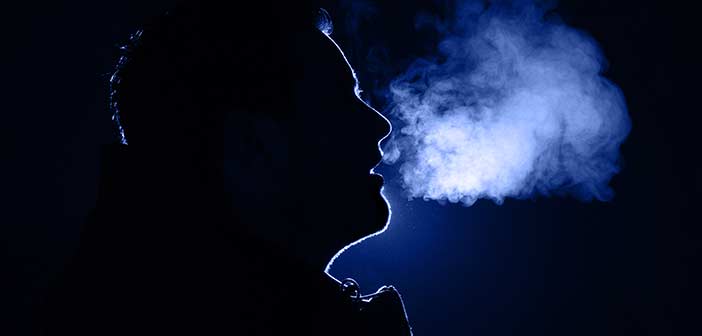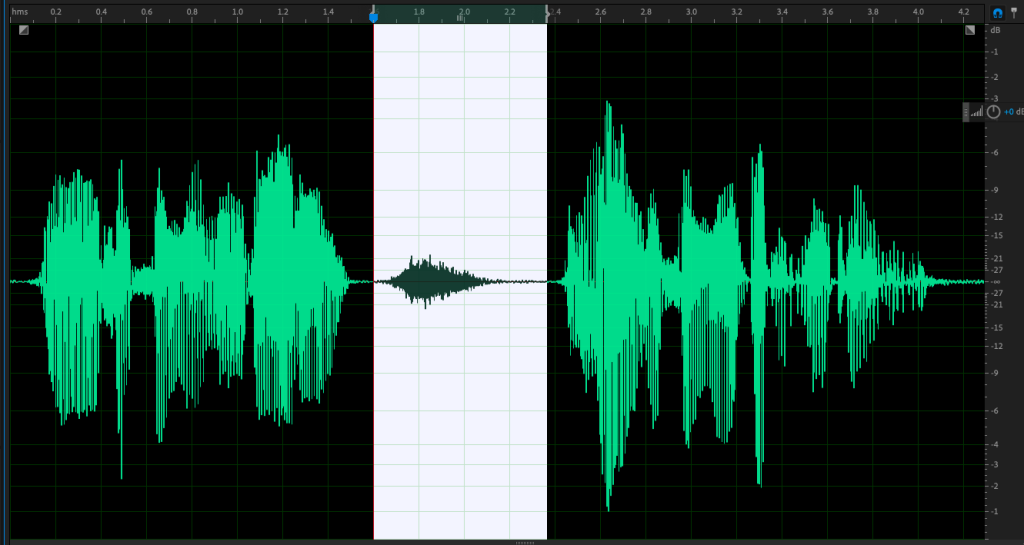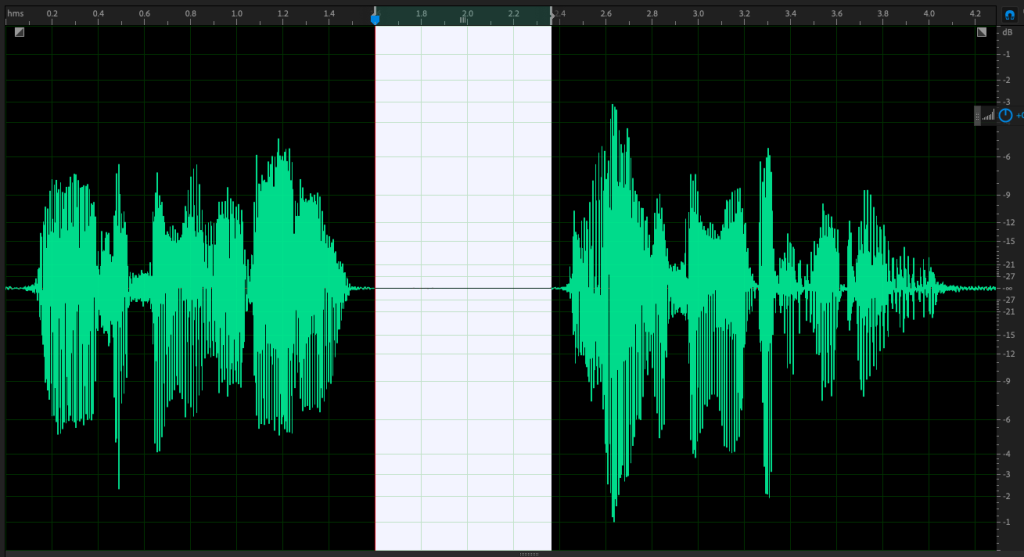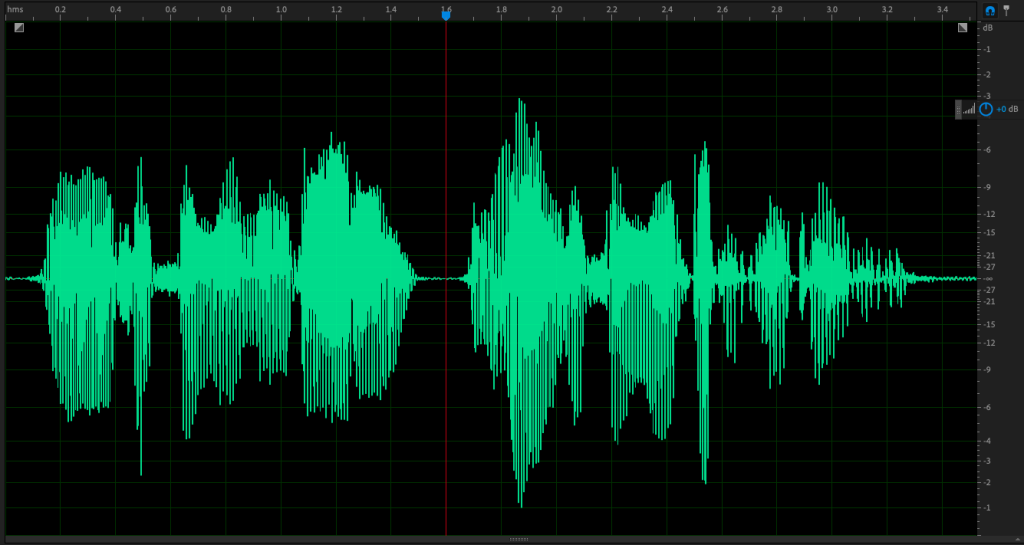
This blog aims to tackle the misconceptions in the voice-over world relating to when you should, and just as importantly when you should not debreath your voice-over recordings. It’s not done correctly that often, but it’s easy to do (in the right place) when you know how.
Firstly, let’s start at the beginning of this topic and answer the question:
What is Debreathing?
Debreathing is where you take a recorded voice performance, you select the breath and you remove it. Here’s a clip recorded in Adobe Audition where you can see the breath highlighted:
and rather predictably, here’s the same clip, but with the breath removed:
Notice here that the breath has actually been silenced rather than deleted. This is an important distinction to note when discussing debreathing audio. If we had actually deleted the breath and it’s space rather than just silenced it, it would look like this:
Which is a different thing. The first has silenced the breath and the second has removed it and the time taken to do it entirely.
So When and Why Would You Debreath a Voice-Over Recording?
Traditionally, one would debreath commercial voice-overs. There are a couple of valid reasons for doing this:
- The advertiser does not want the listener’s focus to be removed in any way from the message, which is the product or service that is being advertised. Even on a subconscious level, having breath in the performances brings the listener back to the fact that this is a human being delivering the message.
- Commercials, especially ones with visuals, are often highly stylised beasts, with varying tempo’s and prosody patterns. In this case the message is not about the voice-over artist but purely the message. Varying the pace or the prosody pattern often increases the number of breaths or their emphasis, and again, this is irrelevant to the message, and often distracting.
- Many commercial voice-overs are purposefully close-miked to get that lovely bass-proximity effect In this case, once the voice-over is properly treated, the breath’s will be much louder proportionally than they would be in real life. This is therefore, a distraction to the message.
- Once voice-over clips are post-produced, i.e., compressed, and then their volume brought up appropriately (through mixing or normalisation) the breath-volume-level is artificially increased. This is a distraction to the message.
Commercial voice-overs need to focus purely on the message, and without distraction, which includes the breath
So what’s the problem? Why isn’t it just that simple, i.e., debreath commercial voice-over and nothing else?
The Problem with Debreathing Commercial Voice-Over
The problem with debreathing commercial voice-over lies in the definition of what commercial voice-over is. Commercial voice-over could be taken as one of two things by the definition of the word. Firstly, it could be taken as voice-over which is used by a company, and which you are paid for, which is therefore, commercial in its nature. Secondly, it could be taken as actual advertisements, either on television, radio, cinema, or web adverts, and therefore commercial in its nature.
Many voice-over artists will debreath both versions of commercial work. Unless we’re specifically asked, we should only debreath the second version… or actual advertisements. Remember, we’re only debreathing so that the message of an advertisement is not distracted in any way.
Why Should We Not Debreath Any Other Types of Voice-Over?
There are a few reasons for not debreathing the first definition of voiceover, corporate work, gaming performances, narrative VO, dramatic VO, Voice of God…and so on.
Firstly, we are all human beings and we are used to hearing people breath when they talk – it’s just part of our natural conversation. If it’s not there, we miss it. Generally with commercial audio (adverts), there is a lot of music in the background, and sometimes effects as well, so we tend not to notice that the breaths aren’t there when we hear them. But if you hear a person talking on their own, and remove all the breathing, it becomes uncomfortable to listen to. We tend to feel unconsciously stressed-out while we’re waiting for this superhuman-lunged person to actually take a breath!
Historically, the best text-to-speech services like Eleven Labs, Siri, or the Google voice. Great though they were…didn’t have audible breathing. In more recent years these have been updated to include breathing as the breath is a part of the human condition, and recordings sound less-human without it…
Secondly, breathing gives a natural pause for the listener to assimilate what has been communicated to them. It allows time for thought processes to happen, and internal decisions to be made. All-too-often, we hear non-advertisement dialogue that has been debreathed and all the space removed. It happens in an awful lot of American radio commercials – the issue is that the audience walks away from the voice-over not really remembering any of it.
Lastly, as the voice-over artist, breathing denotes a natural style of delivery. Natural delivery in voice-over is the current trend and what everyone wants. If you remove the breathing from the performance, by default you remove an element of its naturalness and turn it into something less than it is.
Breathing indicates a natural style of delivery. Remove the breaths and you remove all sense of the naturalness of the piece, and make it less than it is.
Accidentally Removing Breaths in Vocal Recordings
As a last word on the subject, it’s worth pointing out that if you use tools like noise gates or expanders you will be inadvertently removing the breathing as well as the noisy environment. Usually this is in an attempt to clean up the sound of a poor recording environment. This has all the same consequences as removing the breathing in the first place.
Your recording environment may sound better, but you’ve just killed the human element to your performance.
Fix your recording environment, don’t fudge it with noise gates and expanders! That’s the way of the amateur!
In Conclusion
Don’t debreath your voice recordings unless they are specifically for commercial advertising. Even then, make sure you check with your employer, client, or hirer as to whether you actually should.
Your breath is part of the human condition – we need it, we expect it. In an age where we as humans are competing with AI vocals, it’s important that we recognise our humanity and platy to our advantages – leave in your breaths unless you are asked to remove them.
However, if you’re specifically asked to debreath voice-over in other parts of the industry, corporate etc, then ignore this article entirely. Do as you’re told! They pay the fee, after all!
[Updated 2024]



Hugh, this article is spot on! Thanks for sharing these important tidbits about breathing… Also, I think for us as VO people, we tend to be more critical of how a person breathes in a recording, how production sometimes shortens the gaps too much & the just the overall sound of the voice communicating to us. My friends are always like… how did you HEAR that? I just do! & one of my friends was fascinated by what I told her about “vocal fry” the other day. I enjoy sharing with others about the voice field, things they wouldn’t necessarily know. Which I’m sure you do too! Cheers!
Thanks very much Rose! 🙂
The other thing you can experiment with is take the breath out and replace it with a sample of your studio noise floor. This way you maintain the pacing of the piece while removing those breaths. This is a great way to completely alter the pace of your delivery in post. You can in effect make your pauses much longer. This might be useful for poetry reading for instance.
Do you ever recommend just making a breathe quieter and not removing it altogether?
That’s what I’m wondering too as when the audio is normalize- aren’t the breaths too loud?
What about auditions? I was taught to always remove breaths in auditions. Is this still the case?
I have a unique approach. Since I am part Amphibian, I breathe through my Gills.
Good info, especially that last part about unintentional debreathing. Saved me from some potential embarrassments.
I tend to debreath as a matter of preference and practice but just to make it interesting I may sometimes vary how I do it: if the breath was a necessary pause to avoid vocal fry and causes a small blip in my pacing, I’ll delete it with no break in my stride, if it was a breath that complements my pacing or that I used in my pacing, I might paste room noise over it but reduce the space by half of what that breath was. If the breath was either necessary for the performance or, just to finesse the element of humanity that the breath invokes while still trying to keep it nonintrusive, I’ll fade it in, cut a slice out the middle (usually it’s sharpest point) and, if necessary, fade it out. it’s all case by case depending on the length and rhythm and what sounds right. Kind of ‘crafting the human undertones’.
It seems involved but I kinda look at them like brush strokes in a painting; besides, if the piece is long and the breaths plentiful enough, the variation keeps me from going bonkers.
All very useful and practical info bringing light into that little gap filled with our air. Thanks!
Thank you, thank you!! I have pondered the question of when to debreath and when not to debreath for a long time. Thank you for answering my question and saving me a lot of time on future work!
Those first three pictures… aren’t we looking at a click? Showing changes when you amplify, vs when you compress?
Yes. I’m new to all this and, while the description makes perfect and good sense (really useful too), the illustrations seem to be about something else! (clicks & compression, maybe?) and confused me a little. Thanks Hugh.
Peta
WOW! I spent – so much time – de-breathing several audiobooks; all of which were full-length novels, and that’s a lot of breaths. All for no reason it seems. I felt some of the breaths were over-loud or ‘snatched’ to maintain pace and energy; is it okay to silence these, and the rarer, but more extreme gasps?
Great post!
I’d add that with practice and experience I’ve been able to train my ear for when a breath might not be needed or likewise very much needed when editing. Definitely for the natural, conversational speech, not so much for the energetic tone of a advertising where breathing becomes much harsher and more noticeable anyway.
Also – a note on gates, they CAN work if you’re setting them to just take the floor down slightly, say 6-10db. The breaths will still be there, just reduced slightly in volume
Interesting article, I was wondering if I should remove my breaths from audiobook auditions, but this has convinced me I shouldn’t. Thank you for saving me from extra work!!!
Really interesting as I have been silencing my breaths up until now. How about reducing the gain on the more obvious ones, or just leave them?
I am presuming that we are talking about “manual” debreathing here. I have used a plug in – WAVES but it ain’t great. Or maybe I am just not using it properly so at present I am just de-breathing in the editing which is very slow and labourious.
This thread started four years ago. I am wondering if it still holds true that you should only de-breath for commercial work…. I do hope so!!
N
I was just wondering: If I record an audiobook and I have a character in there that’s not human, but like a drone or an AI or something… would debreathing their part of the dialog be a subtle way to make them sound more believable?
I reduce my breaths on auditions and submitted final takes by 60dB. You can still hear the breath if you listen very closely. I’ve never had a complaint on anything submitted for production use nor for audition. Seems like a happy medium.
The exception is if it is a character I use the breath to convey emotion or if it’s appropriate to the scene which the character is involved. If I’m supposed to be running I better be breathing or I have bigger issues to deal with. LOL!